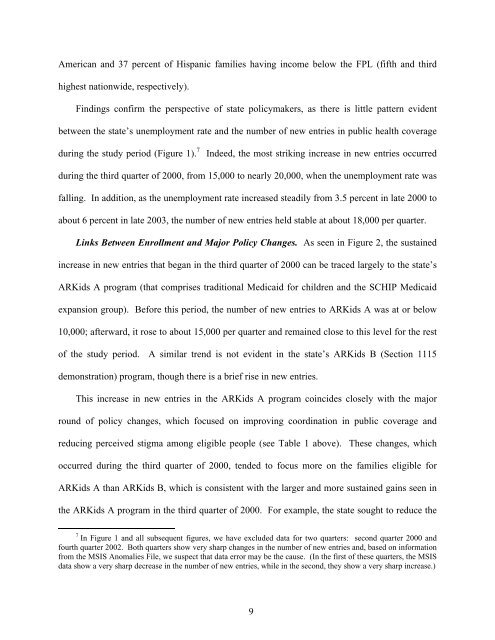Case Study of Arkansas - Mathematica Policy Research
Case Study of Arkansas - Mathematica Policy Research
Case Study of Arkansas - Mathematica Policy Research
Create successful ePaper yourself
Turn your PDF publications into a flip-book with our unique Google optimized e-Paper software.
American and 37 percent <strong>of</strong> Hispanic families having income below the FPL (fifth and third<br />
highest nationwide, respectively).<br />
Findings confirm the perspective <strong>of</strong> state policymakers, as there is little pattern evident<br />
between the state’s unemployment rate and the number <strong>of</strong> new entries in public health coverage<br />
during the study period (Figure 1). 7<br />
Indeed, the most striking increase in new entries occurred<br />
during the third quarter <strong>of</strong> 2000, from 15,000 to nearly 20,000, when the unemployment rate was<br />
falling. In addition, as the unemployment rate increased steadily from 3.5 percent in late 2000 to<br />
about 6 percent in late 2003, the number <strong>of</strong> new entries held stable at about 18,000 per quarter.<br />
Links Between Enrollment and Major <strong>Policy</strong> Changes. As seen in Figure 2, the sustained<br />
increase in new entries that began in the third quarter <strong>of</strong> 2000 can be traced largely to the state’s<br />
ARKids A program (that comprises traditional Medicaid for children and the SCHIP Medicaid<br />
expansion group). Before this period, the number <strong>of</strong> new entries to ARKids A was at or below<br />
10,000; afterward, it rose to about 15,000 per quarter and remained close to this level for the rest<br />
<strong>of</strong> the study period. A similar trend is not evident in the state’s ARKids B (Section 1115<br />
demonstration) program, though there is a brief rise in new entries.<br />
This increase in new entries in the ARKids A program coincides closely with the major<br />
round <strong>of</strong> policy changes, which focused on improving coordination in public coverage and<br />
reducing perceived stigma among eligible people (see Table 1 above). These changes, which<br />
occurred during the third quarter <strong>of</strong> 2000, tended to focus more on the families eligible for<br />
ARKids A than ARKids B, which is consistent with the larger and more sustained gains seen in<br />
the ARKids A program in the third quarter <strong>of</strong> 2000. For example, the state sought to reduce the<br />
7 In Figure 1 and all subsequent figures, we have excluded data for two quarters: second quarter 2000 and<br />
fourth quarter 2002. Both quarters show very sharp changes in the number <strong>of</strong> new entries and, based on information<br />
from the MSIS Anomalies File, we suspect that data error may be the cause. (In the first <strong>of</strong> these quarters, the MSIS<br />
data show a very sharp decrease in the number <strong>of</strong> new entries, while in the second, they show a very sharp increase.)<br />
9
















